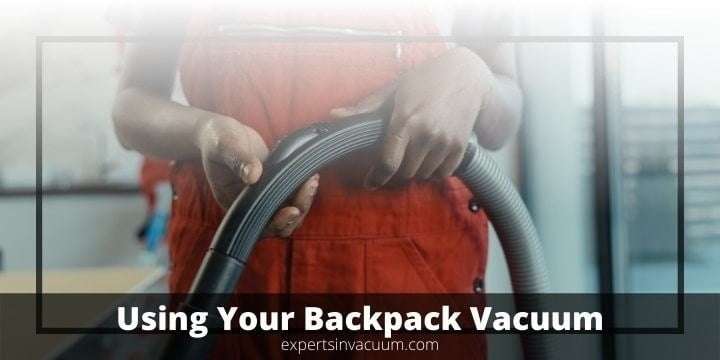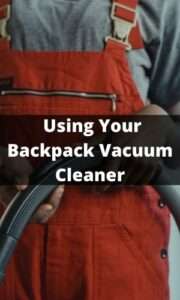A backpack vacuum cleaner has numerous advantages, the most important of which is increased productivity. However, in order to reap the benefits of the machine, you must first understand how to use a backpack vacuum cleaner.
The vacuums have been on the market for over twenty years, and it is reasonable to assume that many people are familiar with how to use them. However, that assumption is incorrect, as most people prefer regular upright or stick vacuums.

Backpack vacuum cleaners are deemed by many as cleaning tools for commercial settings. There are, however, models that can be used in both residential and commercial settings.
This article provides the ultimate guide to how to use a backpack vacuum cleaner. Continue perusing the article to learn more concerning the usage of a backpack vacuum.
In this post we will cover:
- How to Use a Backpack Vacuum Cleaner
- Uses of a backpack vacuum cleaner for residential cleaning
- Uses of a backpack vacuum cleaner for commercial cleaning
- Why should I choose a backpack vacuum cleaner?
- Are backpack vacuum cleaners heavy?
- Key features of a backpack vacuum
How to Use a Backpack Vacuum Cleaner: The Ultimate Guide
Preparing the vacuum and checking for safety
Unwind the cord and inspect it: make sure that you completely unwind the electric cord of the backpack vacuum cleaner.
Then check for any tangles and damages by running your hand down the length of the entire cord before plugging it into a power source.
Test and tag: make sure that the vacuum’s electric cord has a current test and tag. This is where the vacuum undergoes a visual inspection and safety test using a portable appliance tester to make sure that it is fit for use.
Inspect the vacuum for damage: check the machine for damage before and after use. If you find any, put a “Danger” tag on the place and avoid using the machine until it has been cleared for safety by a certified repair agent.
Look for any obstructions: obstructions are things that get logged in different parts of the vacuum that will prevent proper functioning.
Check the floor tool, elbow, wand, and hose of the machine for any obstructions. Get rid of any obstructions you find.
Consider ergonomics: ergonomic issues are essential when using or moving the backpack vacuum cleaner. Avoid instances where the power cord plugs into the supply when you are trying to lift, transport, or relocate the machine.
Adjust the vacuum for comfort: adjust the hose intake to the preferred right or left side. Connect the elbow (the bent piece on the hose), wand, and appropriate floor tool by twisting the joints together.
Loosen the shoulder straps on the vacuum for easy fitting. Adjust the straps for the harness to snug firmly against your back and hips so that a finger can comfortably be inserted under the strap.
How to use a backpack vacuum cleaner
Most first-time users of backpack vacuum cleaners can comfortably use the unit from the start. However, in some cases, the unit needs some getting used to, and this is how to use it:
1. Begin by wearing the vacuum cleaner on your back, and make any adjustments necessary for maximum comfort. Once the unit has been placed comfortably on your back you are ready to start vacuuming.
2. Stand upright because you need to maintain the natural curves of your back while using the backpack vacuum cleaner. Then turn on the machine using the rocker switch located on the vacuum’s side.
3. Place one hand where the hose connects to the machine’s wand and the other hand beyond the wand’s bend. Twists at the waist using a side-to-side motion while keeping the back straight.
Twisting at the waist will be easier on the body and result in faster cleaning. The mistake that is often made by many people is pushing and pulling the wand as though the machine is an upright vacuum.
That is not the way a backpack vacuum is used.
4. When you are using a floor tool to vacuum hard floors, it is best to keep the floor tool at a slight angle to allow airflow. The airflow makes the vacuum’s wand easier to operate.
Move the floor tool across the surface that you are cleaning in a to-and-fro motion, slightly overlapping to complete the area being cleaned.
Do not extend the tool far from your body or the floor surface such that it causes your back to bend.
Having the necessary tools that are easily accessible from the waist belt improves productivity when working with the backpack vacuum cleaner.
5. Turn off the vacuum: the vacuum cleaner should be turned off at the power point when moving to clean a new area.
Ensure that the electrical lead is disconnected by winding and unwinding it completely from the vacuum. The procedure should also be done when you have finished your cleaning.
6. Maintain the dust bag and filter of the vacuum by replacing or disposing of it as required.
Uses of a backpack vacuum cleaner for residential cleaning
Traditionally, homes have been cleaned with upright vacuums and brooms. However, backpack vacuum cleaners can also be used for residential cleaning in the following way:
Vacuuming hard floors and carpet: a backpack vacuum cleans both hard floors and carpet effectively and quickly. Its filtration system can trap both visible and invisible soil and allergens, leaving your floors cleaner and the air healthier.
Use the floor tool to clean the hard floors using a front and back motion. Customize your machine by choosing a floor tool that suits your cleaning needs.
A backpack vacuum also has a brush roll that cleans low to medium pile carpets or medium to high pile carpets. Move the brush roll on the carpet to agitate the dirt and dust on the carpet.
Dumping your duster: the benefits of a backpack vacuum go beyond vacuuming the carpets and floors. In the home setting, you can use the machine to dust and detail all of your household’s horizontal surfaces.
Traditional dusting methods kick dust into the air, only to settle back from where it was removed later on. However, a backpack vacuum will trap fine dust with the detailing accessories for upholstery and hard surfaces.
Extending your reach: the extension wand of the vacuum cleaner will help you to leave no surface uncleaned. The wand provides you with an extra 60 inches of reach, allowing you to go over and beyond.
The wand enables you to clean shelves, architectural details, and air return which can be havens for allergens and dust accumulation.
Uses of a backpack vacuum cleaner for commercial cleaning
Theaters: a backpack vacuum is a great choice for picking up candy wrappers, soil, and food in theaters. It can also work quickly to clean under seats, between aisles, and floors.
Public galleries and museums: extra care is required in such places because of the presence of valuable items. A backpack vacuum has a flexible suction hose that can efficiently clean such places without touching the displayed items.
Since the vacuum is not pushed or pulled along the floor, there will be no risk of toppling exhibitions.
Offices: the portability and lightweight design of a vacuum cleaner make it suitable for cleaning around office furniture. The vacuum can reach areas inaccessible to regular vacuums in office space.
Hotels and restaurants: these areas frequently suffer from liquid spillages, and backpack vacuum cleaners have special protection on their motors. The device will not be damaged should the vacuum suck up any liquid accidentally.
Airplanes: the cabins of airplanes are areas considered to have high traffic, and all the small pieces of trash, crumbs, and soil that are usually found there would be great to clean with a backpack vacuum.
Lifts: the portable and compact design of a backpack vacuum cleaner makes it suitable for lifts because they are tight spaces with weight limits. A backpack vacuum works well in a tight space and it is light enough to carry anywhere.
Conclusion
A backpack vacuum cleaner is not a new cleaning device on the market. However, not everyone who comes across it knows how to properly use it.
While some people may be able to operate it smoothly the first time without any hiccups, others may struggle to work with the machine.
However, using a backpack vacuum cleaner is not an uphill task. The correct way to handle the wand is by pushing it from side to side instead of back and forth motion as with regular vacuum cleaners.
Just follow the process outlined above in our ultimate guide so that you can know how to correctly use a backpack vacuum. You will also come across how to prepare and check the machine before using it.
FAQs
Why should I choose a backpack vacuum cleaner?
The vacuum makes cleaning more efficient since it is designed to be portable. The unit has increased flexibility and maneuverability because you can walk in any space without worrying about the machine fitting in it.
The filter of the vacuum is better and has more power. The HEPA filter helps in sucking up dirt, dust, and debris from the air since it traps 99.97 percent of dust and contaminants from different surfaces.
The machine is better for your posture as you clean with it while standing upright. The vacuum does not require any extreme arm or leg extension, meaning that the chances of injuries are reduced.
Backpack vacuums are among the safest models of vacuums since there are no risks of tripping over the power cord. Since the vacuum is worn on your back, your only focus is on the task at hand.
Are backpack vacuum cleaners heavy?
A backpack vacuum cleaner is not heavy. When you wear the machine on your back, the lifting is done by your back and legs, which is far better.
The vacuums have fewer things on them as they do not have wheels or a mechanism for lowering from upright to vacuuming.
What are the key features of a backpack vacuum?
Capacity: backpack vacuums exist in various sizes on the market with different capacities for collecting dirt. A vacuum with a capacity that allows you to clean several areas without frequent emptying is the best.
Vacuums with larger capacities of 6 quarts and above naturally have a large canister which may be difficult or awkward to carry around. However, they tend to hold more dirt.
Good air filtration: many of the vacuums have true HEPA filtration, which can trap 99.97 percent of the size of 0.3 microns or larger. However, the filtration causes an air pressure drop in the vacuums, leading to slightly less efficiency.
Noise level: since the vacuum is worn on the back, it will be close to your ears. Therefore, the vacuum’s noise level should be as low as possible with ratings below 70 decibels. It should have ultra-quiet functioning.
Weight and mobility: the weight of a backpack vacuum is essential because you will be wearing it on your back while using it. Therefore, it should be comfortable. The majority of the vacuums range in weight from 10 to 18 pounds.
The physical dimension of the machine is also vital as some makeup for the low profile depth and width by adding some height to the canister. The height of a backpack vacuum can range between 20 to 31 inches.
Accessories: a backpack vacuum comes with various accessories for different cleaning tasks, such as cleaning bare floors, stairs, carpets, pet hair, and drapes. The tools diversify cleaning tasks in your home and even in commercial settings.
Warranty: backpack vacuums of good quality created by reputable companies have the backing of a reliable manufacturer’s warranty that protects your investment from any issues with function or defects that are unplanned.
